Bubbles are a beautiful thing to watch while they're inflating or floating along, but they can be extremely messy when they burst.
The U.S. still hasn't recovered from the real estate bubble that burst in 2007. Considering the somewhat tenuous state of the second coming of tech spending, the bubbling costs of college inflation, the seemingly limitless heights of gold prices and the ever-expanding demand for health care as baby boomers ease into retirement, there may be another bubble just around the bend.
Don't tell that to
Las Vegas, which is still trying to pick up the pieces after the housing bubble's pop shattered its real estate industry. Average home prices dropped from $220,000 in 2008 to just $128,000 in the first quarter of this year. As a result, a 3.21% foreclosure rate quoted for the area by RealtyTrac is still the highest in the nation. The good news is that foreclosure rate is a 11.54% improvement from fall of last year. The bad news is that it's only a 7.74% upgrade from the same period last year, is still costing more homeowners their properties than anywhere in America and is having a residual effect on business, with traffic down at McCarran Airport and once-untouchable businesses such as the Sahara casino closing, its owners cited the crisis as a reason.
The Street took a look at five regions that lean heavily on one industry and at just how much they stand to lose should their bubble be the next to go:
Lincoln, Neb.
Unemployment rate: 4.1%
Largest employer: The University of Nebraska
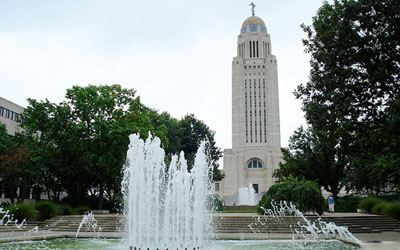 |
The University of Nebraska is the largest employer in Lincoln.
Photo: Tobias Higbie |
As a state capital, Lincoln is usually shielded from the worst effects of bubbles and recessions. As with other state capitals, including Austin, Texas, and Madison, Wis., however, a big part of its stability comes from housing the state's university.
The University of Nebraska employs nearly twice as many people in Lincoln as the state government, and while it's a big part of the reason Lincoln's unemployment rate has fared relatively well compared with that of the rest of the country, it's could also be a weakness if higher education costs ever find a ceiling. According to the nonprofit College Board's annual study of college costs, the average tuition and fees at U.S. public universities have increased at an average of 5.6% per year beyond the rate of inflation. That includes a 9.3% increase in 2009-10 at the height of the recession. As enrollment at state schools rose 33% within the past decade, per-student appropriations dropped 19%.
When those institutions employ large swaths of a city's populace and are under attack, including from low-cost competitors among two-year institutions and a burgeoning online education industry, towns such as Boulder, Colo., Ann Arbor, Mich., and, yes, Lincoln have reason to be concerned.
Killeen-Temple-Fort Hood, Texas
Unemployment rate: 7.9%
Largest employer: U.S. Army
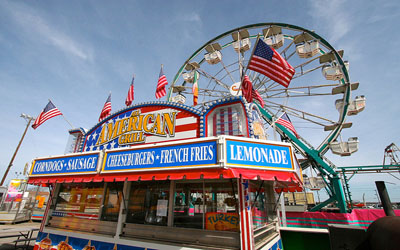 |
One way to amuse yourself in Killeen, Tex.
Photo: flickr|eschipul |
Thinking Fort Hood is immune to military budget fluctuations just because the First Cavalry, 3rd Armored and roughly 65,000 soldiers, supporting staff and families call it home is like dismissing an Army without tanks. Considering the depth of cuts Defense Secretary Robert Gates wanted to make even before Osama bin Laden was killed, all options should be considered on the table.
With politicians from both parties discussing drawdowns in Iraq and Afghanistan in the wake of bin Laden's death, communities such as Navy-dependent Jacksonville, Fla., and Air Force base-adjacent San Bernardino, Calif., and Valparaiso, Fla., have reason to believe those conflicts and U.S. commitment in Libya represent a military spending bubble. Gates wants $100 billion to come out of the now $690 billion defense budget within the next five years, but the cuts haven't hit the bases so far.
While he's already "determined that we will not repeat what we did in the 1970s and 1990s, which is across-the-board cuts that end up hollowing out the force," ask the folks in Lima, Ohio, how seriously he's considering cuts. For those who know Lima only from episodes of Fox's Glee, it's also home to the General Dynamics' Joint Systems Manufacturing Center, which makes the M1A1 Abrams tank and the Marines' Expeditionary Fighting Vehicle. Gates wants to cease production at the plant in 2013-16 to save roughly $1 billion -- marking the first break in U.S. tank production since 1941.
Much of Gates' cuts are targeted toward weapons programs, but he has also called for shrinking the size of the Army and the Marine Corps and hacking the Pentagon budget down to less than 1% growth next year. With political sentiment shifting away from spending of nearly any sort as the U.S. hit its debt ceiling, military communities such as that surrounding Fort Hood shouldn't be surprised when those cuts hit home.
San Jose/San Francisco/Silicon Valley
Unemployment rate: 10.3%
Largest employers: A patchwork of technology companies
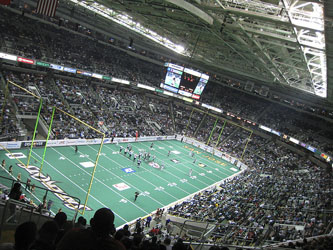 |
Arena football entertains the digiterati in San Jose, CA.
Photo: flickr|bryce_edwards |
If any community knows just how quickly the tech tide can turn, it's San Jose. After the tech boom of the late 1990s pushed the Nasdaq to 5,132.52 in March 2000 and its subsequent collapse drove it to below 2,500 by that December, Silicon Valley high-tech industries dropped off by 17% and roughly 85,000 jobs just disappeared by 2008, according to the Bureau of Labor Statistics. Jobs in the Internet community, telecom and data processing alone declined 26% between 2000- 08.
San Jose, San Francisco and the rest of Silicon Valley are bracing for Round 2 as companies such as Farmville maker Zynga and Twitter are IPO gossip fodder while even mainstays including Google, Cisco and Intel are eyeing advances by Apple and purchases by Microsoft before making their next move. Though the amount of venture capital flowing in for the little guys last year is less than a quarter of the $8.5 billion that came rushing into Silicon Valley at the peak of the tech boom, according to Thompson Reuters, Tesla's IPO last year, the rising star of Facebook's still 20-something Mark Zuckerberg and the renewed presence of big money and big risk in the air still has locals and some investors nervous.
Pittsburgh, Pa.
Unemployment rate: 7.4%
Largest employer: The University of Pittsburgh Medical Center
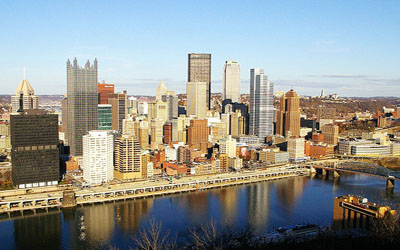 |
Pittsburgh's economy relies upon healthcare spending.
Photo: flickr|kla4067 |
It's almost a shame a town so hard hit by the industrial decline of the late 1970s and early 1980s has become a perfect storm of bubbles. The University of Pittsburgh is still one of the town's largest employers, the empty manufacturing facilities are being populated by tech startups and arguably the biggest employer in town is the University of Pittsburgh Medical Center -- which is, yes, separate from the university from which it takes its name.
The last may be the most volatile of Pittsburgh's three rivers of revenue, as Pittsburgh and other health care heavy towns such as Augusta, Ga., and Boston may not have to wait for the baby boomers to blow through to see their bubble burst. According to health care consulting firm Millman, American families insured through their jobs are racking up an average of $19,393 in health care costs, up 7.3% from last year.
In fewer than nine years, the cost of health care has more than doubled. Hospital spending, which is only 48% of total health care spending, accounts for 60% of the increase. If you consider this kind of growth unsustainable, join the club.
The nation's still sharply divided over President Barack Obama's health care law and none of this posturing has cut so much as a cent from costs, and communities that lean heavily on their hospitals will bear the brunt of it. Pittsburgh knows this too well already; a University of Pittsburgh Medical Center hospital in its Braddock neighborhood was closed just last year.
Elko, Nev.
Unemployment rate: 7.9%
Largest employers: Barrick and Newmont mining companies
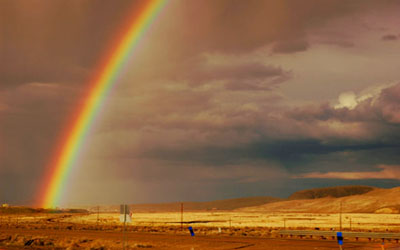 |
Is there a pot of gold on the Elko, Nev. horizon?
Photo: iStockphoto |
We recently mentioned little Elko and its population of less than 20,000 as an example of a town whose one biggest asset -- the gold it's sitting on -- got it through the recession. While that precious commodity has kept Elko's unemployment rate at roughly half that of Nevada as a whole, it's also a volatile and finite resource than takes as much as it gives.
Gold's trading at roughly $1,490 an ounce, which is a whole lot better than the $561.50 it was fetching five years ago, but well down from a high of nearly $1,565 per ounce in April. Unfortunately for gold and, eventually, for Elko, a good economy is bad for gold prices.
Few places know this better than Elko, where plummeting gold prices dropped to less than $265 per ounce between 1999 and 2001 and forced the mining companies to cut back on jobs and the city to cut back on services.
"Gold is a boom and bust industry," Curtis Calder, Elko's city manager, told Fortune in 2009. "When the rest of the economy drops, the price of gold goes up. We're pretty vibrant right now."
That's the best advice a boom or bubble town can get: Savor the now.
By Jason Notte, The Street
Jun 2, 2011































